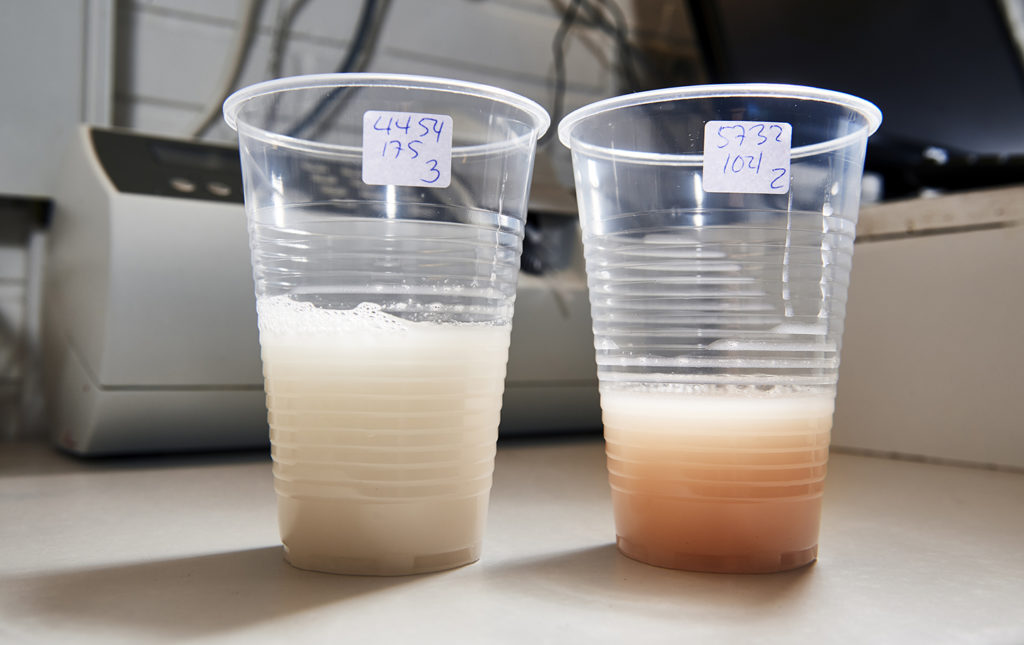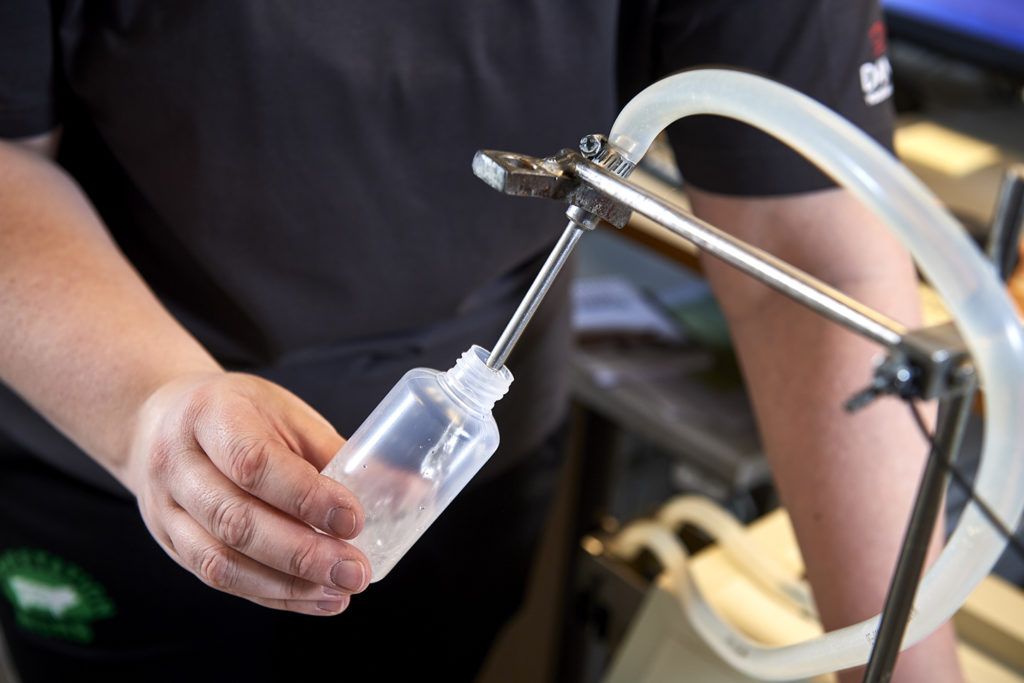Prepare semen doses – correct procedures
Content
Preparation of semen doses
The correct procedures in transforming the raw ejaculate into ready-to-use semen doses will maintain the uncompromised value and help unlock the full reproductive potential of DanBred genetics on farm
How to prepare raw semen for AI application
To obtain the outstanding reproductive results DanBred genetics can deliver, good quality boar semen I essential. When following the correct procedures in transforming the raw ejaculate into ready-to-use semen doses will maintain the uncompromised value and help unlock the full reproductive potential of DanBred genetics on-farm.
Transformation into ready-to-use semen doses
The first step in semen production is a quality assurance of the raw ejaculate. The semen should reach the laboratory within 15-20 minutes after collection. In the laboratory the quality evaluation protocol initiated.
Colour and odour is not a direct component of semen quality evaluation but is a valuable indicator of the boars’ health and productive output. The ejaculate should have a milky white colour and must not have a noticeable odour. If abnormal appearances happen, it should be discarded and not used. Furthermore, the boar should be seen by the herd veterinarian (Rozeboom, 2000).
Motility describes the ability of sperm to move properly forward and is important for the sperm ability to move through the reproductive tract. Because semen motility decreases during storage, semen should be tested shortly after collection and subsequently, the diluted semen dose should be re-tested after 2-3 days of proper storage. The minimum motility rates during initial evaluation should be 90-80 % – with motility cut off level at 70-60 % (DPRCa, 2018).
| Motile Sperm Cells | Semen Quality | Expected productivity |
| 90 % | Very Good |
Excellent |
| 80 % | Good | |
| 70 – 60 % | Sub-standard | Reduced |
| 40 – 20 % | Poor | Very reduced |
| < 20 % | Unusable | Non-productive |
Morphology is the study of the form or shape. The morphology assessment determents the percentage of abnormal sperm cells. Semen with less than 70 % morphologically normal sperm can be identified as poor quality why the ejaculate should be discarded if the assessment is below this level (Rozeboom, 2000).

Sub-standard motility levels, as well as an odd number of abnormal cells found with young boar, can be a sign that the boar not mature for production or a sign of disease. Continue evaluating the semen of the young boar until the results are acceptable and make sure to have the boar examined by the herd veterinarian.
Sperm concentration in the ejaculate describes the number of sperm cells in the collected amount and is an important value, as this together with a total volume of the ejaculate, it will determine the number of doses which can be prepared. The concentration of the semen can be determined by using a haemocytometer under a microscope, by using a calorimeter or a photometer or by using Computer Assisted Semen Analysis (CASA) (Althouse et al., 2015). The concentration of sperm cells should be above 150 bill./ml (DPRCb, 2018).
Investing in equipment will maximise the use of sperm by optimising the number of doses produced and consequently increase the economic and genetic gain on-farm. The DanBred recommendation is to dilute the semen to 2-2.1 billion (109) sperms per dose containing 80-85 ml diluted semen (DPRCa, 2018). Under-diluting semen, will give a higher concentration but can, besides reducing the optimum number of doses produced, result in a shorter shelf life because the amount of available energy substrates in the extender will exhaust sooner than expected. On the other hand over-diluted semen, with a low sperm count, will potentially cause reduced semen viability and thereby decrease the farrowing rate and potentially increase the number of non-productive days on-farm (Althouse et al., 2015).
The choice of extender depends on availability as well as production setup. Depending on the active ingredients in the extender, semen doses can be stored between 3 to 8 days without significant loss of fertility potential (Althouse et al., 2015).
Water for semen dilution must be purified either by distillation or demineralisation. Tap water cannot be used at the content of minerals as well as variable levels of chemicals, organic compounds, microorganisms and endotoxins can harm the semen. Ensure water hygiene by never using tools or thermometers in the container, as well as ensuring that water is only taken out and never returned into the hygienic container (DPRCa, 2018).
It is a fact that boar sperm is very susceptible to fluctuations in temperature and semen temperatures below 15°C will result in a loss of viability and efficiency why semen doses should be kept at a very steady temperature (DPRCa, 2018). At collection the semen has a temperature of 37°C while doing quality assessment as well as dilution of the semen it is very important to keep the temperature around 35°C until the semen has been filled into tubes, flatbacks or bottles, now the doses can be transferred to a temperature-controlled storage facility at 16-18°C.
Easy work flow on preparing semen doses for AI
Before collecting the semen make sure the extender is prepared.

Prepare the extender
- Prepare the liquid extender in a single-use, disposable plastic bag.
- Use demineralised or distilled water.
- Carefully follow the instructions provided by the extender manufacturer.
- Dissolve the extender in the amount of water described by the manufacturer.
- Place the dissolved extender in a water bath at 35-37°C for a minimum of 1 hour to allow for temperature and pH equilibration.


Batch register the semen
- Register the boar ID number.
- Register the boar race.
- Register the date of collection.
Semen evaluation
- Measure the volume of raw semen collected (by weight: 1 Gram = 1 Millilitre).
- Check the colour and odour (must be milky white with no odour).
- Calculate the concentration (using a haemocytometer, a calorimeter, a photometer or CASA.
- Check Semen morphology (>70 % morphologically normal sperm cells).
- Check Semen motility level: 90-80 % (Motility cut off level: 70-60%).
Semen Motility should be evaluated in the ejaculate as well as in the ready-to-use semen dose after 2-3 days of storage.
Calculations
The number of doses must be calculated to know the amount of extender needed:
The number of doses:
# Doses = Concentration of raw semen (sperms/ml) X Total volume of raw semen (ml) X motility rate
Number of sperms per dose (sperms/dose)
The mixing ratio:
The total volume of diluted semen (ml) = # Doses – Size of the dose (ml)
Volume of diluted extender (ml) = Total volume of diluted semen (ml) – volume of raw semen (ml)

Prepare the semen doses
- Measure out the amount the needed volume of the diluted extender.
- Maintain the temperature at 30-35°C
- Add the raw semen into the extender.
- Test a sample of the diluted semen to see that the semen is still viable.
- Fill the diluted semen into tubes, flatbacks or bottles.
Place the ready-to-use doses in a temperature-controlled storage facility at 16-18°C.
References
Althouse, G.C.; Levis, D.G. Diehl, J. (2015): Semen Collection, Evaluation and Processing in the Boar, Pork Information Gateway, Fact sheet, Retrieved online 09/07/19 http://porkgateway.org/wp-content/uploads/2015/07/semen-collection-evaluation1.pdf
Danish Pig Research Centre (DPRC)a; H6D – Intern KS – Fremstilling af sæddoser (2018): Online, Manual om repromanagement. SEGES Videncenter for Svineproduktion. Retrieved 08/05/19 https://svineproduktion.dk/Viden/I-stalden/Management/Manualer/Repro
Danish Pig Research Centre (DPRC)b; H6C – Intern KS – Tapning af orne (2018): Online, Manual om repromanagement. SEGES Videncenter for Svineproduktion. Retrieved 08/05/19 https://svineproduktion.dk/Viden/I-stalden/Management/Manualer/Repro
Danish Pig Research Centre (DPRC)c; H6B – Opbevaring af sæd (2018). Online, Manual om repromanagement. SEGES Videncenter for Svineproduktion. Retrieved 08/05/19 https://svineproduktion.dk/Viden/I-stalden/Management/Manualer/Repro
Rozeboom, K. J. (2000): Evaluating Boar Semen, Extension Swine Husbandry, Publication no. ANS 00-812S Quality, North Carolina State University. Retrieved online 9/5/19 https://projects.ncsu.edu/project/swine_extension/publications/factsheets/812s.htm




